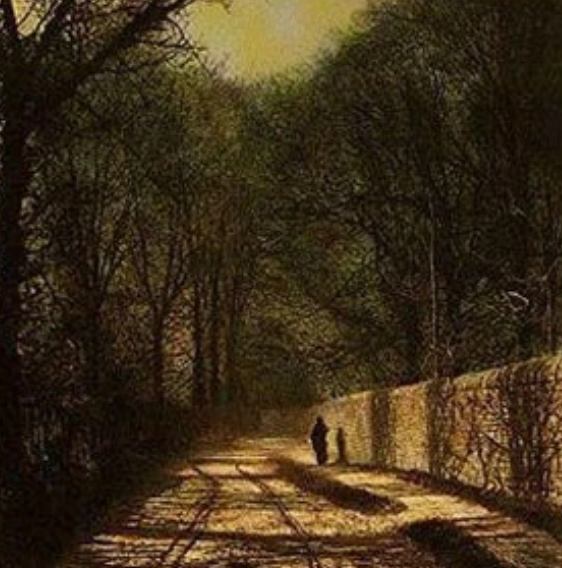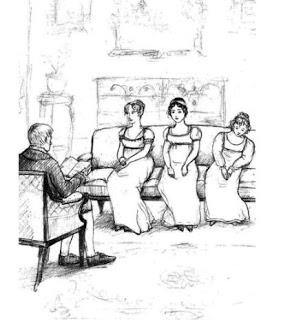Jane Austen’s Women and Their Creative Skills
She was a plain, motherly kind of woman, who had worked hard in her youth, and now thought herself entitled to the occasional holiday of a tea-visit; and having formerly owed much to Mr Woodhouse's kindness, felt his particular claim on her to leave her neat parlour, hung round with fancy-work, whenever she could, and win or lose a few sixpences by his fireside. Emma If you watch movie re-makes of Jane Austen’s novels you could be forgiven for thinking that sewing and craft was this strange, irrelevant activity performed by Regency women. In one movie Jane and Cassandra Austen are sequestered in a dark room while Jane wrestles an incredibly small piece of fabric - its not quite clear what she is doing with the needle. In another the actress appears not to know what to do with a needle and thread, she tosses the fabric around and around until the end of the scene where she may just possibly start to embroider.
 In a world where most western women engage in sewing and other crafty activities for enjoyment, it is very easy to forget the importance of sewing to Jane Austen and her Regency women. It really was very much “women’s work” - both plain and fancy work formed such a large part of any Georgian woman’s duties that she was said to “be at work” when sewing.
In a world where most western women engage in sewing and other crafty activities for enjoyment, it is very easy to forget the importance of sewing to Jane Austen and her Regency women. It really was very much “women’s work” - both plain and fancy work formed such a large part of any Georgian woman’s duties that she was said to “be at work” when sewing.
 Examples of men’s shirts, cravats and waistcoats from that time show the ability of women to make that small, neat running stitch. These pieces also show their skill in pattern making and cutting. A new shirt or dress was often traced or copied from another, and then adapted for the fashion. Decorative Pieces Charles Bingley and his sister Caroline in Pride and Prejudice start a conversation about an accomplished woman’s decorative creative skills, understood to be ‘fancy work’.
Examples of men’s shirts, cravats and waistcoats from that time show the ability of women to make that small, neat running stitch. These pieces also show their skill in pattern making and cutting. A new shirt or dress was often traced or copied from another, and then adapted for the fashion. Decorative Pieces Charles Bingley and his sister Caroline in Pride and Prejudice start a conversation about an accomplished woman’s decorative creative skills, understood to be ‘fancy work’.
 Embroidery was a very popular creative skill of the era, it was an easily transportable skill - when visiting friends or family a workbag of embroidery could be taken along. By the Regency era, embroidery designs had moved away from religious symbols to floral designs. Floral designs were often worked in crewel work, woollen thread on a heavier linen for bedding and in tambour using the crochet hook like needle to work a fast colourful chain stitch across the top of the fabric. There were also a wide range of other types of embroidery. Whitework was particularly popular amongst the gentry to work an imitation lace - white work stitches on a fine muslin or cotton could give the appearance of lace, which was far too expensive for most of Jane Austen’s characters to buy. Such whitework pieces were then turned into caps, cuffs or handkerchiefs.
Embroidery was a very popular creative skill of the era, it was an easily transportable skill - when visiting friends or family a workbag of embroidery could be taken along. By the Regency era, embroidery designs had moved away from religious symbols to floral designs. Floral designs were often worked in crewel work, woollen thread on a heavier linen for bedding and in tambour using the crochet hook like needle to work a fast colourful chain stitch across the top of the fabric. There were also a wide range of other types of embroidery. Whitework was particularly popular amongst the gentry to work an imitation lace - white work stitches on a fine muslin or cotton could give the appearance of lace, which was far too expensive for most of Jane Austen’s characters to buy. Such whitework pieces were then turned into caps, cuffs or handkerchiefs.
Jennifer Forest is the author of the best selling book, Jane Austen's Sewing Box. Inspired by the arts and crafts in Jane Austen's novels, she joined history and craft together in a new way - using research into these Regency craft skills to create beautiful and useful projects today. The book includes instructions and full color photographs of the following handcrafts: A Letter case, Linen cravat, Linen pillowcases, Workbags, Paper flowers, Knitted and netted purses, Huswife, Carpet work, Muff and Tippet, Pin cushion and thread case, Transparency, Bonnet, Reticule, Knitted rug, and Muslin caps. The Jane Austen Handbook: A Sensible yet Elegant Guide to Her World

“My dear Catherine.... your head runs too much upon Bath, but there is a time for everything - a time for balls and plays, and a time for work.” Northanger AbbeyWomen’s Work Women provided a highly valuable economic service for their families with their sewing skills. With plain sewing they provided much needed clothing for their family in an age without sewing machines and large quantities of mass produced clothing. In rural areas away from a wide selection of shops, such as the areas where many of Jane Austen’s characters lived, it was also more practical. While dresses and coats were often made by a dress maker, Regency women of Jane Austen’s class at least made the men’s shirts and cravats, nightdresses for all the family and some children’s clothing. In 1799 Jane Austen is staying at her brother Edward’s house when she comments about her running stitch:
“We are very busy making Edward’s shirts and I am proud to say I am the neatest worker of the Party”.
 Examples of men’s shirts, cravats and waistcoats from that time show the ability of women to make that small, neat running stitch. These pieces also show their skill in pattern making and cutting. A new shirt or dress was often traced or copied from another, and then adapted for the fashion. Decorative Pieces Charles Bingley and his sister Caroline in Pride and Prejudice start a conversation about an accomplished woman’s decorative creative skills, understood to be ‘fancy work’.
Examples of men’s shirts, cravats and waistcoats from that time show the ability of women to make that small, neat running stitch. These pieces also show their skill in pattern making and cutting. A new shirt or dress was often traced or copied from another, and then adapted for the fashion. Decorative Pieces Charles Bingley and his sister Caroline in Pride and Prejudice start a conversation about an accomplished woman’s decorative creative skills, understood to be ‘fancy work’.
“All young ladies accomplished! My dear Charles, what do you mean? “Yes, all of them I think. They all paint tables, cover screens and net purses...... I am sure I never heard of a young lady spoken of for the first time, without being informed that she was very accomplished.”In this area of decorative fancy work, many Regency gentlewomen were highly skilled in painting, drawing, decoupage, embroidery, netting and design. Being able to produce a decent drawing was evidence of education and accomplishment; as was making presents such as a netted purse for a brother, or covering screens to be used by the fire as Elinor Dashwood paints in Sense and Sensibility.
 Embroidery was a very popular creative skill of the era, it was an easily transportable skill - when visiting friends or family a workbag of embroidery could be taken along. By the Regency era, embroidery designs had moved away from religious symbols to floral designs. Floral designs were often worked in crewel work, woollen thread on a heavier linen for bedding and in tambour using the crochet hook like needle to work a fast colourful chain stitch across the top of the fabric. There were also a wide range of other types of embroidery. Whitework was particularly popular amongst the gentry to work an imitation lace - white work stitches on a fine muslin or cotton could give the appearance of lace, which was far too expensive for most of Jane Austen’s characters to buy. Such whitework pieces were then turned into caps, cuffs or handkerchiefs.
Embroidery was a very popular creative skill of the era, it was an easily transportable skill - when visiting friends or family a workbag of embroidery could be taken along. By the Regency era, embroidery designs had moved away from religious symbols to floral designs. Floral designs were often worked in crewel work, woollen thread on a heavier linen for bedding and in tambour using the crochet hook like needle to work a fast colourful chain stitch across the top of the fabric. There were also a wide range of other types of embroidery. Whitework was particularly popular amongst the gentry to work an imitation lace - white work stitches on a fine muslin or cotton could give the appearance of lace, which was far too expensive for most of Jane Austen’s characters to buy. Such whitework pieces were then turned into caps, cuffs or handkerchiefs.Jennifer Forest is the author of the best selling book, Jane Austen's Sewing Box. Inspired by the arts and crafts in Jane Austen's novels, she joined history and craft together in a new way - using research into these Regency craft skills to create beautiful and useful projects today. The book includes instructions and full color photographs of the following handcrafts: A Letter case, Linen cravat, Linen pillowcases, Workbags, Paper flowers, Knitted and netted purses, Huswife, Carpet work, Muff and Tippet, Pin cushion and thread case, Transparency, Bonnet, Reticule, Knitted rug, and Muslin caps. The Jane Austen Handbook: A Sensible yet Elegant Guide to Her World



2 comments
[…] To learn more about Regency needlework, click here. […]
Stitching with Jane Austen | JASNA GREATER PHX
Bingley’s quote in this article is what brought me to this website. I know what he means by covering screens and netting purses, but what is painting tables? Caroline Bingley is rapturous over Miss Darcy’s design for a table. Is this the same thing?
Anonymous
Leave a comment
This site is protected by hCaptcha and the hCaptcha Privacy Policy and Terms of Service apply.